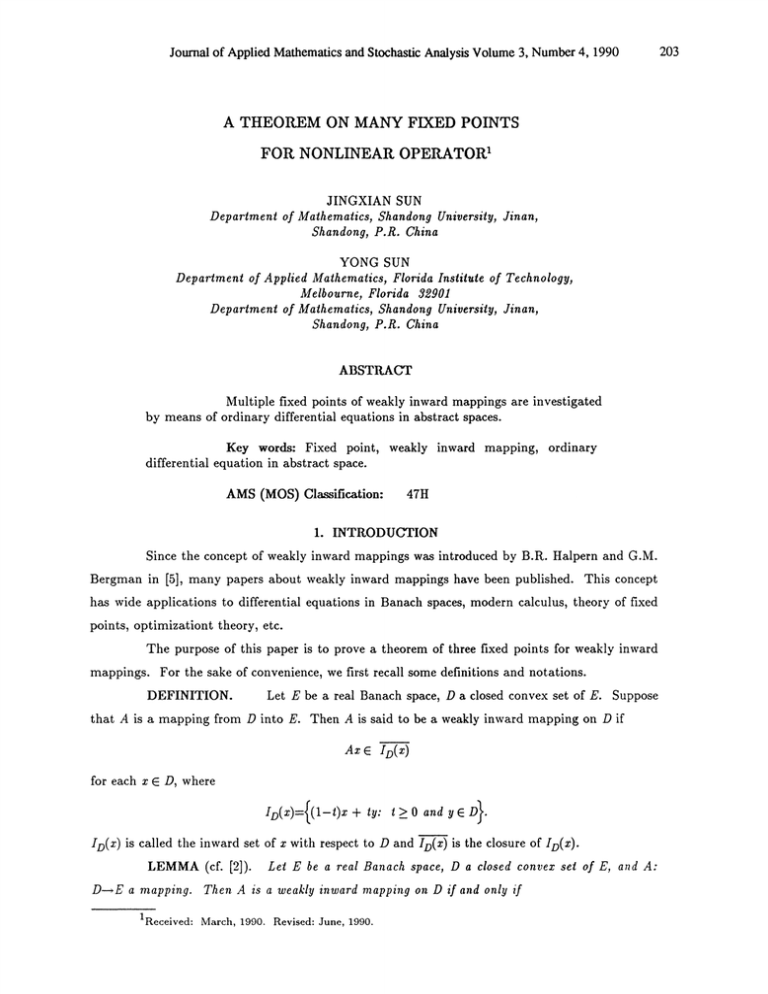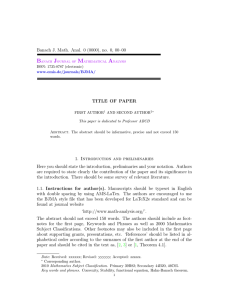FIXED A MANY POINTS
advertisement

Journal of Applied Mathematics and Stochastic Analysis Volume 3. Number 4, 1990
A THEOIM ON MANY FIXED POINTS
FOR NONLINEAR OPERATOR
JINGXIAN SUN
Department of Mathematics, Shandong University, Jinan,
Shandong, P.R. China
YONG SUN
Department of Applied Mathematics, Florida Instilute of Technology,
Melbourne, Florida 3901
Department of Mathematics, Shandong University, Jinan,
Shandon#, P.R. China
ABSTICT
Multiple fixed points of weakly inward mappings are investigated
by means of ordinary differential equations in abstract spaces.
Key words: Fixed point, weakly inward mapping, ordinary
differential equation in abstract space.
AMS (MOS) Classification:
47H
1. INTRODUCTION
Since the concept of weakly inward mappings was introduced by B.R. Halpern and G.M.
Bergman in [5], many papers about weakly inward mappings have been published. This concept
has wide applications to differential equations in Banach spaces, modern calculus, theory of fixed
points, optimizationt theory, etc.
The purpose of this paper is to prove a theorem of three fixed points for weakly inward
mappings. For the sake of convenience, we first recall some definitions and notations.
Let E be a real Banach space, D a closed convex set of E. Suppose
that A is a mapping from D into E. Then A is said to be a weakly inward mapping on D if
DEFINITION.
for each z E D, where
ID(Z) is called the inward set of x with respect to D and ID(Z)is the closure of ID(Z).
LEMMA (cf. [2]). Lel E be a real Banach space, O a closed convex set of E,
DE a mapping. Then A
1Received:
is a weakly inward mapping on
March, 1990. Revised: June, 1990.
D if and only if
and A:
203
2O4
Journal of Applied Mathematics and Stochastic Analysis Volume 3, Number 4, 1990
lira
--,+0
where
d(x+t(Ax-x), D) denotes the
}d(x+t(Az-x), D)=0, z C D,
distance between
z+t(Az-x)
and
n.
2. MAIN RESULT
We now state the main result of this paper.
TtIEOIEM.
Let E be a real Banach space, D a bounded closed convex set of E,
and A: D ---,E a strict-set-contraction and weakly inward mapping. Suppose that A satisfies a local Lipschitz condition; and there exist two relatively open convex sets D1 and D2 of D,
D1 n D2 5 such that A is weakly inward on D1 adn D2 respectively. Suppose further that A
has no fixed points on OD1 and OD2 (where OD1 and OD2 are the boundary of D1 and D2 with respect to D respectively). Then A has at least three fixed points on D.
PROOF.
Consider the IVP
,
u,=Au-u, u(0)=x E D
in Banach space E. It can be proved that
IVP(2) has
a unique solution
(2)
u(t, x)
on
[0, + c,)
for
each z E D, and
u(t, z)Dforanyt>0.
Define, for each
>_ 0,
U(t)z-=u(t,z),
Then
U(t)
(3)
is an operator and from
z C D.
(4)
(3)it follows that
U(OD C D.
(5)
We know, in the same way, that
(6)
since A is weakly inward on D1 and D2 respectively. It follows from A I satisfying local
Lipschitz condition that U(t) is continuous by continuous dependence of solutions on the initial
values.
It is possible to show, by using the same arguments as those of the proof of Theorem 4.8
in
[3],
that
a( U(t)(B)) <_
for any
>_. 0
and B C D, where
a(.
e-(-k)tc(B)
is Kratowskii’s measure of noncompactness and 0
the coefficient of strict-set-contraction of A (i.e., a(A(B))
follows that U(t): D---,D is strict-set-contraction for each
_< k < 1
< k.a(B) for any B C D). From
> 0.
is
this it
A Theorem on Many Fixed Points for a Nonlinear Operator: Sun and Sun
205
We now show that a positive number c can be found such that U(t) has no fixed points
on the boundary of D for any 0 < < c. In fact, if it is the contrary, then n > 0 (n= 1, 2, ...)
can be found such that tn---*O and U(ln) has fixed point
Xtn on the boundary of D1. Therefore, we
ht,v
ztn)=U(tn)Xtn=Ztn
u(tn,
OD,
a=l, 2,
for s >_ 0. Then it follows from the proof of Theorem 4.8 in
Let Un(S)=U(S x
uni(s) of lUn(S) which uniformly converges to z E on
exists a subsequence
[3] that there
[0, +c)as n
goes to infinity, where z is a fixed point of A. Therefore,
z )= lim
lim oo z = lim oo
n i’-*
n
n
i’*
This is in contradiction with A having no fixed points on the boundary of D1. This
and z E OD1.
Uni(tni)=z
U(tni,
r$
implies that a positive number c can be found such that
of D1 for any 0
such that
Then
< _<
U(t) has
c.
In the same way we
can show that a positive number c, can be found
no fixed points on the boundary of
U(t) has. no fixed
U(t) has no fixed points on the boundary
D2 for any (0) < < c,.
Let c*=min{c, c,).
< < c*.
points on the boundary of D1 and the boundary of D2 for any 0
And
from this and
where i(.,.,
(5), (6)
it follows that, for any 0
< < c*,
i(U(t), D1, D)=I,
(7)
i(U(t), D2, D)=I,
(8)
i(U(t), D, D)=I,
(9)
,)
is the fixed point index, whose definition and properties can be found in
D3=DI(D:t UD2).
Then by (7),
[6]. Let
(8)and (9) we have
i(U(t), D3, D)=1-1-1=-1.
Therefore, by the solvability of fixed point index, U(t) has fixed points in D1, D2 and
0
D3for each
< t < c*, respectively.
We finally show that A has
such that
D3. In fact, if we select
m
> 0(re=l, 2,...)
tm--*O as m goes to infinity, and let Xtm be the fixed point of U(tm), then
t(Tlm,
Denote Um(S)=u(s
xt,) for s > 0.
Xtm)-- U( tm)Xt m-Xt rn 03.
Then it follows from the proof of Theorem 4.8 in
__Umk(S) of__tUm(S))can be found such that umk(s
[3] that
a
uniformly converges to Zl( E on
as m k goes to infinity and zl is a fixed point of A. This implies
subsequence
[0, + c)
a fixed point in
lira x
m k "* cx
mk
=
lim
m k "*
u(tmk, x m k )=
lira
m k "* cx
Um
k mk
2O6
Journal of Applied Mathematics and Stochastic Analysis Volume 3, Number 4, 1990
so z E 33, and hence it follows from
A having no fixed points on the boundary of D3, which is
the union of the boundary of D 1 and the boundary of D2, that z1 is in D3. Thus, A has a fixed
point in D3. We can prove, by the same reasoning, that A has fixed points in D1 and D2
respectively. Hence A has three fixed points on D and the proof is completed.
We can only conclude that A has two fixed points in D under the
REMAI’CK 1.
conditions of this Theorem by using Theorem 4.8 in [3], i.e., A has fixed points in D1 and D2
respectively, and the third fixed point of A in D can not be obtained.
3. EXAMPLE
Let us now show an example. Suppose that the real Banach space E is R2. Let
0_<
Ol={(x y) E2. 0<$<1, O<y<l),
D2=D U D and
2< <
D"
f’z
0
20 -40},
2
and let the operator A from D into
2 be
A(z,y)=(y-z(x-1)(z-5),-y).
The Theorem will be applied to show that A has
three fixed points in D. In order to do this,
A is weakly inward on D, D1
and D2 respectively and A has no fixed points
on the boundary of D1 and D2 with respect to D.
we verify that
5
In fact, it is easy to show that A" D--+R 2 is weakly
x
D-’’.
We now show
D and on
the right side
on
Clearly, it is sufficient to show that A(x, y) is
that A is weakly inward on
of the line y=20x-40 for 2 < x < 9/4 and y=20x-40, and to verify the following:
D’-.
on
the z coordinate of A(2,0)
_> 2,
(0)
the y coordinate of A(2,0)
>_ 0,
(11)
the z coordinate of A(9/4,
5) >_ 9//4
(2)
the y coordinate of A(9/4,
5) _< 5.
(13)
It is easy to check that (10) (13) hold. We now show that A(x,y) is on the right side
of the line y=20x-40 for 2 < x < 9/4 and y=20z-40. In order to do this, we should show
A Theorem on Many Fixed Points for a Nonlinear Operator: Sun and Sun
holds for 2
207
-y <_ 20y-2Oz(x-1)(x-5)-40
< x < 9//4 and y=20z-40. Substituting y=20x-40 in (14) gives
(i4)
20x(:-l)(z-5)-21(20z-40)+40 _< 0, 2 < < 9/4.
(15)
Define a function g(z) on R 1 by
g(x)=20z-(z-1)(x-5)-21(20x-40)+40.
Then
g(2)=40. (1). (-3)+40=-80 < O,
and
g,( x)=20 z-( z- 1 )+ 20 z-( z-5 )+ 20( x- 1 )( z-5 )-420=20(3 2_ 12
We know that equation g,(z)=O has two real solutions
-
16 ).
zl.-2-8/3,
Since g(z) is a quadratic function that opens upward, we get
g’(xl)=g’(x2)=O,
and
g,(z) < 0 for zl < z < z2.
(16)
g,(z) < 0 for 2 <_ z <_ 9/4
(17)
And hence,
by virtue of
that
(16) and
x1
< 2 < 9/4 < z2. From g(2) < 0 and g,(z) < 0
for 2
_< x < 94,
it follows
g(z) < 0 for 2 <_ z <_ 9/4.
(15) holds, i.e., (14) holds. Hence, A(z, y)is on the right side of the
y=20z-40 for 2 < z < 9/4 and y=20x-40. This yields that A is weakly inward on D2.
This implies that
line
On the other hand, we can show that A has no fixed points on the boundary of D1 and
D2 with respect to D. Therefore the conditions of the Theorem are fulfilled by the operator A,
and hence A has three fixed points in D.
The fixed points of operator A in the above example can be
REMARK 2.
obtained by solving the equation A(z, y)=(z, y) directly, which are (0, 0)in D1, (3+-, 0)in D2
and (3--, 0) in D3.
Journal of Applied Mathematics and Stochastic Analysis Volume 3, Number 4, 1990
208
[3]
[5]
[6]
REFERENCES
Browder, F.E., Nonlinear Operators and Nonlinear Equations of Evolution in Banach
Spaces. Proc. Sympoc. Pure Math., Vol. 18II, Amer. Math. Soc., 1976.
Deimling, K., Nonlinear Functional Analysis. Springer-Verlag, 1985.
Deimling, K., Ordinary Differential Equations in Banach Spaces. Springer-Verlag, 1977.
Guo, D., Sun, J., Ordinary Differential Equations in Abstract Spaces. Shandong
Science and Technique Press, (1989), (in Chinese).
Halpern, B.R., Bergman, G.M., A fixed point theorem for inward and outward maps.
Trans. AMS., 130 (1968), 353-358.
Nussbaum, R.D., The fixed point index for local condensing maps. Ann. Math. Pure
Appl., 89 (1971)q, 217-258.


